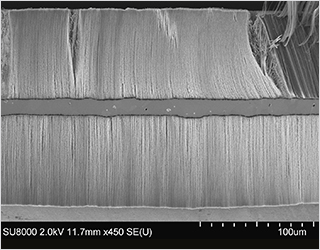Upscaling of PVD and CVD methods for deposition of CNT for battery applications

In the last three years, a close cooperation with the US start-up Zeta ENERGY Corp. has been established, which aims at the development of industrial processes for the deposition of carbon nanotubes (CNT) for battery applications.
In 2019, the company Zeta ENERGY approached us with the task of depositing very thin metal and metal oxide layers on thin metal strips. These layers are used as a catalyst for the growth of carbon nanotubes (CNT), which form the anode in customer‘s novel battery concept. Magnetron sputtering and electron beam evaporation were to be comparatively evaluated as deposition technologies. Our in-line vacuum coating equipment for metal strips and sheets MAXI was used for the evaporation and the coating plant ILA 900 for the sputtering processes.
In the further course of the project, the low-pressure CVD technology developed by Zeta in the laboratory for the deposition of CNTs was to be scaled up using the pilot plant MAXI. For this purpose, the first step was to develop the concept for a CVD module that could be integrated into the MAXI. During this phase, a close, trusting cooperation with the customer evolved. Weekly online meetings and regular on-site discussions at the Fraunhofer FEP quickly became established. The CVD module was designed and manufactured in the Fraunhofer FEP‘s systems department. It was ready for assembly in the MAXI at the beginning of 2022.
The module was then taken into operation together with experts from Zeta. The parameters found at Zeta in the laboratory were transferred and very soon the first CNT were successfully deposited in the MAXI plant.
Systematic investigations of the influence of the process parameters on the growth of CNT followed. In this way, it became possible to understand and to control the growth processes of the CNT better and better. A decisive factor in this was also the very committed participation of the Analytical Department of Fraunhofer FEP. High-resolution electron micrographs provide an impressive view on the grown CNT. Ultimately, it was possible to deposit approx. 80 µm long, vertically oriented CNT on both sides of a 15 µm thick copper foil and to image them in cross-section.
The collaboration with Zeta is to be continued. The focus will be on the transition to roll-to-roll deposition, with the aim of significantly increasing productivity. We look forward to overcoming new challenges in close cooperation.
 Fraunhofer Institute for Electron Beam
Fraunhofer Institute for Electron Beam